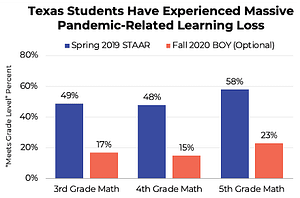The following testimony was delivered to the Texas Senate Committee on Education.
The COVID-19 pandemic has resulted in massive learning loss for students across Texas. According to one estimate, students could end the year as many as 9 months behind in math proficiency, with low-income students and students of color at risk of falling even further behind. Even before the pandemic, too many Texas students were struggling academically: only 45% of Texas 3rd graders were reading on grade level, and only 35% of low-income 3rd graders. The pandemic threatens to dramatically worsen these challenges, with massive implications to our state’s economy for decades to come.
 Texas public schools are set to receive more than $17 billion in one-time stimulus funding to address learning loss and better prepare schools for the current pandemic reality. This funding is a once-in-a-generation opportunity to not only help Texas students get back on track, but close achievement gaps among student groups that have existed long before the pandemic. But to fully maximize this opportunity, it is critical that decision-makers spend these funds on evidence-based programs and strategies.
Texas public schools are set to receive more than $17 billion in one-time stimulus funding to address learning loss and better prepare schools for the current pandemic reality. This funding is a once-in-a-generation opportunity to not only help Texas students get back on track, but close achievement gaps among student groups that have existed long before the pandemic. But to fully maximize this opportunity, it is critical that decision-makers spend these funds on evidence-based programs and strategies.
House Bill 4465 sets up an effective framework for districts to access federal stimulus dollars and help their students recover from COVID learning loss. It offers districts 5 broad options for utilizing stimulus funds that are each supported by research and evidence. Policies such as summer school and extended school day can ensure students receive more instruction, while innovative curriculums and accelerated learning can ensure students are receiving better instruction as well. Other options such as broadband grants will allow more Texas students to access learning opportunities outside of the classroom.
Importantly, each of these 5 options can also be scaled up or down depending on the availability of funding. For the long-term health of districts, it is critical that we don’t inadvertently create recurring costs and dangerous fiscal cliffs down the road. By identifying these 5 strategies, HB 4465 ensures that districts invest in strategies that will improve student outcomes while protecting their long-term financial health.
